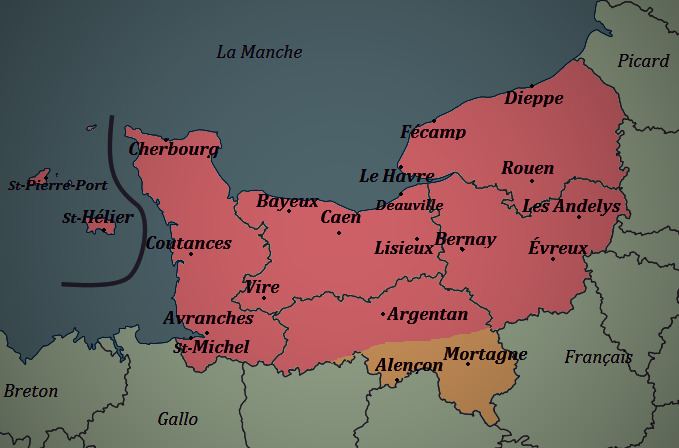 | ||
Native to NormandyJersey, Guernsey, Sark, EnglandPreviously used:Alderney, HermEngland (see Norman England)Ireland (see: Norman Ireland)Canada (formerly used to a certain degree in Eastern Canada and Quebec)Kingdom of Sicily (used in a limited degree)Principality of Antioch Native speakers ca. 100,000 (date missing)* Auregnais: 0 (extinct)Guernésiais: ~1,300 (has government support)Jèrriais: ~4,000 (has government support)Sercquiais: <20 in 1998 (highly endangered)Augeron: <100 (highly endangered)Cauchois: ~50,000 (has local support)Cotentinais: ~50,000 (has local support) Language family Indo-EuropeanItalicRomanceWesternGallo-RomanceOïlNorman Dialects AuregnaisGuernésiaisJèrriaisSercquiaisAugeronCauchoisCotentinais | ||
Norman (Normaund, French: Normand, Guernésiais: Normand, Jèrriais: Nouormand) is a Romance language which can be classified as one of the Oïl languages along with Picard and Walloon. The name Norman-French is sometimes used to describe not only the Norman language, but also the administrative languages of Anglo-Norman and Law French used in England. For the most part, the written forms of Norman and modern French are intercomprehensible.
Contents
Geographical distribution
Norman is spoken in mainland Normandy in France where it has no official status, but is classed as a regional language. It is taught in a few colleges near Cherbourg-Octeville.
In the Channel Islands, the Norman language has developed separately, but not in isolation, to form what are recognized as Jèrriais (in Jersey), Guernésiais or Guernsey French (in Guernsey) and Sercquiais (or Sarkese, in Sark). Jèrriais and Guernésiais are recognized as regional languages by the British and Irish governments within the framework of the British–Irish Council. Sercquiais is in fact a descendant of the 16th century Jèrriais used by the original colonists from Jersey who settled the then uninhabited island.
The last first language speakers of Auregnais, the dialect of Norman spoken on Alderney, died during the 20th century, although some rememberers still exist. The dialect of Herm also lapsed, at an unknown date.
An isogloss termed the "Joret line" (ligne Joret) separates the northern and southern dialects of the Norman language (the line is from Granville, Manche to the French-speaking Belgian border in the province of Hainaut and Thiérache). There are also dialectal differences between western and eastern dialects.
Three different standardized spellings are used: continental Norman, Jèrriais, and Dgèrnésiais. These represent the different developments and particular literary histories of the varieties of Norman. Norman may therefore be described as a pluricentric language.
The Anglo-Norman dialect of Norman was a language of administration in England following the Norman conquest of England in 1066. This left a legacy of Law French in the language of English courts (though it was also influenced by Parisian French). In Ireland, Norman remained strongest in the area of south-east Ireland, where the Hiberno-Normans invaded in 1169. Norman is still in (limited) use for some very formal legal purposes in the UK, such as when the monarch gives Royal Assent to an Act of Parliament using the phrase, "La Reyne (le Roy) le veult" ("The Queen (the King) Wills It").
The Norman conquest of southern Italy also brought the language to Sicily and the southern part of the Italian Peninsula, where it has left a few traces in the Sicilian language. See: Norman French and French influence on Sicilian.
Literature in Norman ranges from early Anglo-Norman literature through the 19th-century Norman literary renaissance to modern writers (see list of Norman-language writers).
Today, the Norman language is strongest in the less accessible areas of the former Duchy of Normandy: the Channel Islands and the Cotentin Peninsula (Cotentinais) in the west, and the Pays de Caux (Cauchois dialect) in the east. Ease of access from Paris and the popularity of the coastal resorts of central Normandy, such as Deauville, in the 19th century led to a significant loss of distinctive Norman culture in the central low-lying areas of Normandy.
History
When Norse invaders from modern day Denmark and Norway arrived in the then-province of Neustria and settled the land that became known as Normandy, these Germanic-speaking people came to live among a local Romance-speaking population. In time, the communities converged, so that Normandy continued to form the name of the region while the original Normans became assimilated by the Gallo-Romance people, adopting their speech. Later when conquering England, the Norman rulers in England would eventually assimilate, thereby adopting the speech of the local English. However, in both cases, the élites contributed elements of their own language to the newly enriched languages that developed in the territories.
In Normandy, the new Norman language inherited vocabulary from Old Norse. The influence on phonology is more disputed, although it is argued that the retention of aspirated /h/ and /k/ in Norman is due to Norse influence.
Examples of Norman words of Norse origin:
In some cases, Norse words adopted in Norman have been borrowed into French – and more recently some of the English words used in French can be traced back to Norman origins.
Following the Norman conquest of England in 1066, the Norman language spoken by the new rulers of England left traces of specifically Norman words that can be distinguished from the equivalent lexical items in French:
Other borrowings, such as captain, kennel, cattle and canvas, exemplify how Norman retained Latin /k/ that was not retained in French.
Norman immigrants to North America also introduced some "Normanisms" to Quebec French and the French language in Canada generally. Joual, a working class sociolect of Quebec, in particular exhibits a Norman influence. Some expressions that are currently in use in Canada are:
